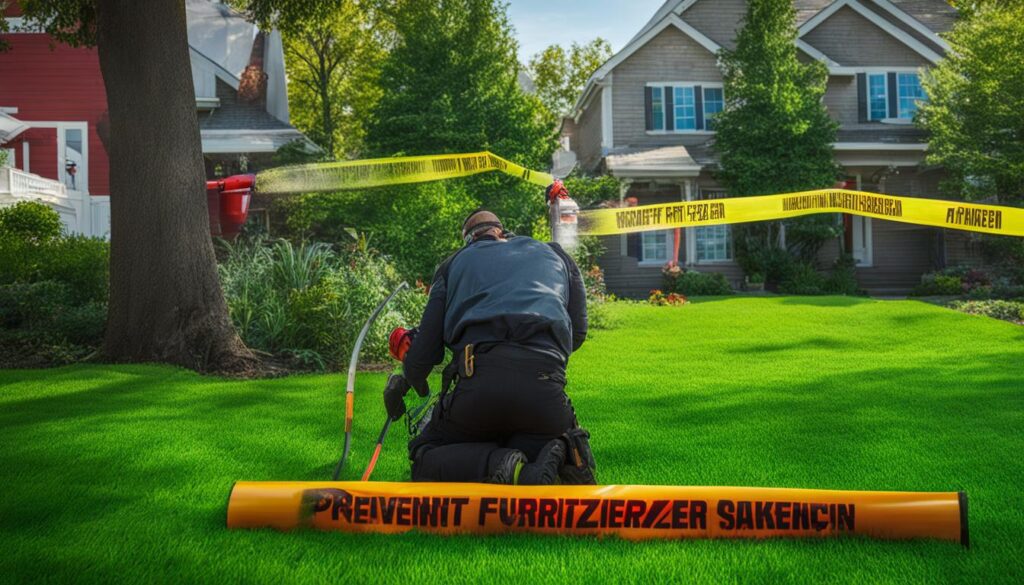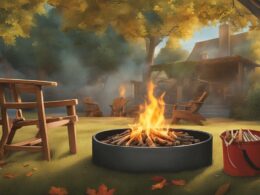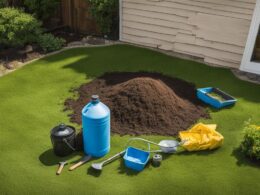Is your lawn suffering from the damaging effects of fertilizer burn grass? Don’t worry, you’re not alone. Fertilizer burn is a common issue that occurs when grass is over-fertilized, leading to yellow or brown patches resembling burned areas. But fear not, because there are steps you can take to treat fertilizer burn grass and prevent future damage, resulting in a lush and healthy yard.
What is Fertilizer Burn?
Fertilizer burn is a common gardening mistake that can have detrimental effects on your lawn. When too much fertilizer is applied or when fertilizer is applied over wet plants or grass, it can lead to scorched or burned plants. This occurs because the salts present in the fertilizer extract excess moisture from the grass or plants, causing them to appear yellow or brown and burned.
Recognizing the signs of fertilizer burn is crucial in addressing the issue promptly. By understanding the causes and effects of fertilizer burn, you can take the necessary steps to prevent and treat this problem in your garden.
How to Fix Fertilizer Burn
To fix fertilizer burn, you need to take steps to reduce the amount of fertilizer present in the soil. Start by removing as much excess fertilizer as possible from your lawn. This can be done by gently raking or sweeping away the visible granules and debris. Be careful not to damage the grass or soil in the process.
Once you have removed the excess fertilizer, it’s important to rinse the soil with water. This will help to dissolve the salts in the fertilizer and remove any built-up residue. Gently water the affected areas, making sure to saturate the soil. Aim to apply about 1 inch of water daily for 4 to 7 days to help flush out the excess fertilizer.
If your grass still doesn’t recover after rinsing the soil, it may be necessary to reseed the affected areas. Choose a high-quality grass seed that is suitable for your climate and grass type. Prepare the soil by loosening it with a rake or garden fork, then evenly spread the grass seed over the bare patches. Lightly rake the seed into the soil and water thoroughly.
Remember to keep the reseeded areas moist by lightly watering them daily. This will help the new grass seed establish roots and fill in the affected areas. With time, proper care, and patience, your lawn can recover from fertilizer burn and regain its healthy and vibrant appearance.
How to Prevent Fertilizer Burn
To prevent fertilizer burn, there are several steps you can take.
- Use slow-release fertilizer to gradually release salts into the soil and reduce the likelihood of over-fertilization.
- Avoid applying fertilizer to wet grass and ensure the grass and soil are dry before fertilizing.
- Water the lawn well after applying granular fertilizers to remove excess fertilizer from the blades of grass and ensure even spreading.
- Consider using compost or organic fertilizer that is less likely to cause fertilizer burn.
- Research the appropriate amount of fertilizer for your lawn and avoid over-fertilizing.
- Avoid applying fertilizer during drought as it can remain concentrated in the soil.
Final Thoughts
Fertilizer burn doesn’t mean your grass is ruined. By following these lawn care tips and solutions, you can save your grass, return it to a healthier state, and prevent future fertilizer burn. It’s important to save your grass not only for its aesthetic appeal but also for its environmental benefits.
When working with fertilizer, it’s crucial to avoid water runoff to prevent harm to animals and other plants. Excessive runoff can lead to water pollution and nutrient imbalance in aquatic ecosystems. To prevent this, use the following lawn care practices:
- Avoid over-fertilization: Applying more fertilizer than recommended can increase the risk of fertilizer burn. Use the correct amount of fertilizer for your specific lawn.
- Choose slow-release fertilizer: Slow-release fertilizers gradually release nutrients, reducing the chances of over-fertilization.
- Apply fertilizer when the grass is dry: Wet grass can make it difficult for the fertilizer to properly absorb, leading to uneven distribution and potential burn.
- Water your lawn after fertilizer application: Watering your lawn after applying fertilizer helps to flush away any excess nutrients and prevent concentrated areas of fertilizer that could potentially cause burn.
- Consider organic or compost-based fertilizers: These alternatives are less likely to cause fertilizer burn and offer additional benefits to the soil.
By implementing these lawn care tips, you can maintain a healthy and thriving yard while preventing future fertilizer burn. Remember, proper lawn care goes beyond just aesthetics—it’s about creating a sustainable and vibrant environment for you and your community to enjoy.
With these prevention tips, you can confidently care for your lawn and avoid the pitfalls of fertilizer burn. Remember to always read the instructions on fertilizer packaging, follow the recommended application rates, and practice responsible lawn care. Your efforts will be rewarded with a beautiful, lush, and healthy yard that you can enjoy for years to come.
Signs of Fertilizer Burn in Your Lawn
If you notice your lawn exhibiting certain characteristics, it may be indicative of fertilizer burn. Common signs of fertilizer burn include:
- Yellow or brown grass: The presence of yellow or brown patches on your lawn is a clear indication of fertilizer burn. These areas may have an unnatural color and appear dry.
- Lack of new grass growth: If you observe a lack of new grass growth or stunted growth in certain areas, it could be a sign that those areas have been affected by fertilizer burn.
- Patches of dead grass: Dead patches of grass that are completely brown and lifeless can also be a result of fertilizer burn. These patches may be scattered throughout your lawn.
- Burned areas resembling scorch marks: Fertilizer burn can sometimes create distinct streaks or splotches on the grass, resembling scorch marks. These burned areas can be unsightly and disrupt the overall appearance of your lawn.
If you observe any of these signs in your lawn, it is important to take action to treat and revive the affected areas. Ignoring fertilizer burn can lead to further damage and hinder the health and beauty of your lawn.
Can the Tips for Healing Fertilizer Burn on Grass Also Help with Red Thread Grass Cure?
Applying lawn recovery tips can aid in healing fertilizer burn on grass as well as addressing red thread grass cure. Proper watering, aeration, and using a balanced fertilizer can promote overall lawn health and help in combating issues such as fertilizer burn and red thread disease.
Conclusion
In conclusion, fertilizer burn grass can be a common mistake in lawn care that results in yellow or brown patches and scorched grass. However, it is a problem that can be treated and prevented by following proper lawn care practices. By using slow-release fertilizer, avoiding fertilizing wet grass, and applying the correct amount of fertilizer, you can maintain a healthy and vibrant lawn.
Regular inspection of your lawn is essential to identify signs of fertilizer burn early and take appropriate actions to fix it. Removing excess fertilizer, rinsing the soil with water, and reseeding affected areas are effective methods to heal your lawn from fertilizer burn grass effects. Additionally, preventing fertilizer burn is crucial for the long-term health of your yard.
To prevent future fertilizer burn, make sure to choose the right type of fertilizer and apply it according to the recommended guidelines. Consider using organic or compost-based fertilizers that are less likely to cause damage. Moreover, always water your lawn after applying fertilizer to remove any excess and prevent concentrated salts from causing harm to your grass.
By implementing these prevention tips and practicing regular lawn care maintenance, you can enjoy a lush, green, and healthy yard that is free from the effects of fertilizer burn grass. Remember, a well-cared-for lawn is not only visually appealing but also creates a welcoming outdoor space for you, your family, and your guests to enjoy.










